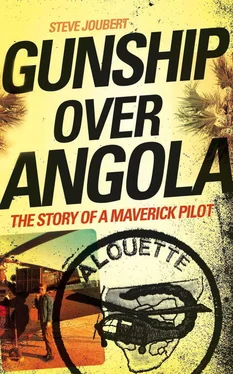So, I initiated a slight turn to the left.
I tried to match the natural features, such as hills and rivers, that we were passing on the ground with the corresponding symbols and squiggles on the map unfolding on my knee, but it all rapidly became a blurred jumble of confusion.
So, I turned a little further left.
Halfway through the leg I thought (erroneously) that I recognised a hill-and-stream combination that seemed to correspond to the map. It showed that I was right of the track.
So, I turned a little more to the left.
Major Klaasen said nothing. He just sat there, as was his role, and observed me turn left. Then left again, and then left again.
Finally, we emerged from a gap between two cloud-covered hills and a small town appeared directly in front of us. My navigation skills were such that I knew there were no towns anywhere close to the track that the aircraft was supposed to be on.
‘I think that I have drifted off track,’ I mumbled into the microphone.
‘No shit, Sherrrrrrrrrrlock!’ guffawed the major.
‘Do you go to Prrrrrretorrrrrria on the weekends?’ he asked.
‘Yes. Sometimes.’ I replied.
‘Then you should rrrrrrrrecognise the town of Brrrrrrrrrrandfort! We are now only 18 miles off trrrrrrack! That is a worrrrrrrld rrrrrrrrecord deviation for a 40-mile leg! Congrrrrrrrratulations!’ he trumpeted with great mirth and a total absence of malice.
Repositioning to where we were supposed to be, I managed to progress through the remaining two legs of the navigation exercise without further incident. Major Klaasen then put me through my paces in rigorously testing the full range of my newly accumulated Alo III flying skills, and declared that I had managed to meet the minimum standards demanded.
All that remained was for me to redo the navigation section of the test, albeit on a very different and more difficult route, which I did successfully the following day.
A popular social expression at the time was to ask someone who’d just demonstrated some cleverness, ‘So, does that make you a chopper pilot?’ I could now truthfully reply in the affirmative.
*
I really loved the Alo III, but, the next step towards an operational flying role in the SAAF was converting to the far larger and infinitely more sophisticated AérospatialePuma. The twin-engine, twin-pilot Puma was a state-of-the art medium-category military helicopter capable of fulfilling multiple operational roles, primarily in deploying up to 16 heavily armed soldiers onto the battlefield. It was flown by a breed of extraordinarily brave men.
Upon successful completion of a Puma conversion course at 19 Squadron B Flight at AFB Swartkop, the plan was that we newly qualified Puma pilots would be deployed to an operational SAAF squadron as co-pilots, also called sandsakke (sandbags or ballast) for approximately two years, after which – with sufficient experience and competence – we would be able to apply for a command (captaincy) of this fine aircraft.
My course mates all seemed to love this powerful aircraft and all its electronic and instrumental sophistication. However, from the outset of the conversion course, I dreaded the idea of sitting in the Puma’s left-hand seat for the next two years. My enthusiasm continued to wane as the course progressed, fortunately not to the detriment of my ability to fly the Puma but sufficiently so for me to take a firm decision to take remedial action at the first available opportunity.
That moment arrived within minutes of my completing the final flying test on the course. I walked determinedly into the office of the squadron commander, the legendary Major ‘Monster’ Wilkens, and asked him to help me transfer to 17 Squadron, which was stationed just a short distance away.
‘But they fly the Alo!’ he said with some surprise.
‘Their pilots log pilot-in-command hours, sir,’ I replied. ‘And they are all commanders.’
‘Are you absolutely certain that you want to go to 17?’ he asked.
‘Yes, I am, sir.’
He looked at me for quite a long time and asked if I’d like to take a day or two to reconsider this unprecedented and drastic step.
‘I want to fly Alos, sir, and thinking about it for a few days won’t change that decision.’
‘Well, okay then. I’ll give the 17 Squadron OC (officer commanding) a call and see how amenable he is to your request and I’ll get back to you.’
‘Please call him now, Major?’ I pleaded.
He looked at me quizzically, perhaps even with a shade of pity, then picked up the phone and called Commandant André Bekker, OC 17 Squadron. After a brief conversation, during which he outlined my insane request, he asked me, ‘Commandant Bekker would like to know how many hours you have?’
‘Almost 500, sir,’ I responded quickly, knowing full well that the absolute minimum required to get an operational command on choppers in the SAAF was normally 500 hours. I actually had around 497 hours at the time, thanks to having accumulated an extra 150 or so hours in the few months I’d spent at CFS Dunnottar’s Station Flight doing test flights with the stasieslette and grabbing every ‘jolly-ride’ in sight.
After he put the phone down, Major Wilkens looked at me and said, ‘Commandant Bekker is happy to give you a chance, but you need to go there right now and then pass their 17 Squadron competency test today.’
By the time he got to ‘competency test today’ I was already out of the door and bound for the 17 Squadron buildings, situated just 300 metres away. I was immediately sent into the hangar to familiarise myself with the Alo III again. Once I’d gone over the aircraft operating protocols and emergency procedures a few times on my own in a stationary aircraft, the 17 Squadron instructor put me through an intensive and probing two-hour evaluation of my Alo III competency.
My luck held. I passed the assessment and was immediately welcomed to the squadron as a fully-fledged Alo III commander.
The downside was that, the very next day, I boarded a Safair Lockheed L-100-30 troop-carrying aircraft (the civilian version of the C-130), known as a ‘Flossie’, and flew 2 000 kilometres to Ondangwa in Ovamboland, the centre of airborne operations in far northern South West Africa (today Namibia) during the Border War, for the first of many operational tours.
For just over two decades, I had enjoyed the privilege of growing up in circumstances that sheltered me from the unsavoury realities faced by so many of my countrymen on a daily basis. I’d never been required to take the political situation in South Africa seriously at all.
That was about to change.
Although I was not yet aware of it, at this early stage of my career there was already ample evidence of my discomfort with the military way of doing things. Consequently, I often ran up against the military’s strict protocols, and faced censure for it. Perhaps I have my mom to thank for this, as she raised me to question everything that I didn’t understand. The result was that I was never able to swallow the military’s ideological story. My personal political principles, as poorly developed as they were, rebelled against the prevailing conservatism. Although I had learnt to keep my beliefs strictly to myself, I found it difficult to hide my contemptuous expression when confronted with orders and opinions that I disrespected.
This is not to say that I was a raging liberal masquerading as a military officer. I just felt that there was more to life than the military and that I, rather than they, should determine the path I followed. I had read Ayn Rand’s novel The Fountainhead for the first time in my mid-teens, and had come to the conclusion that, like the novel’s protagonist, Howard Roark, I was an avid objectivist. To me, this meant that you cannot control much of what happens to you in life but that you are totally responsible for how you respond to life’s challenges. So, I would hoe my own furrow and accept the consequences of doing so.
Читать дальше












